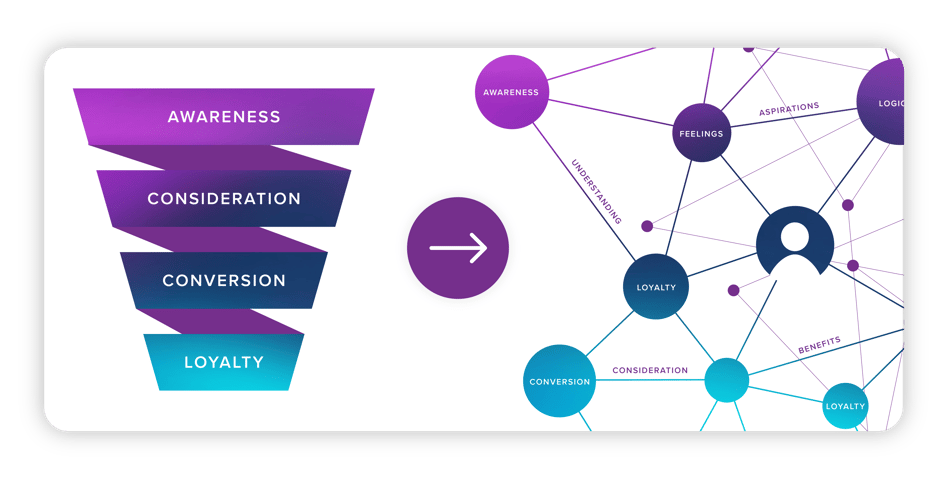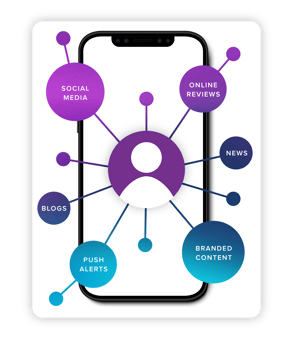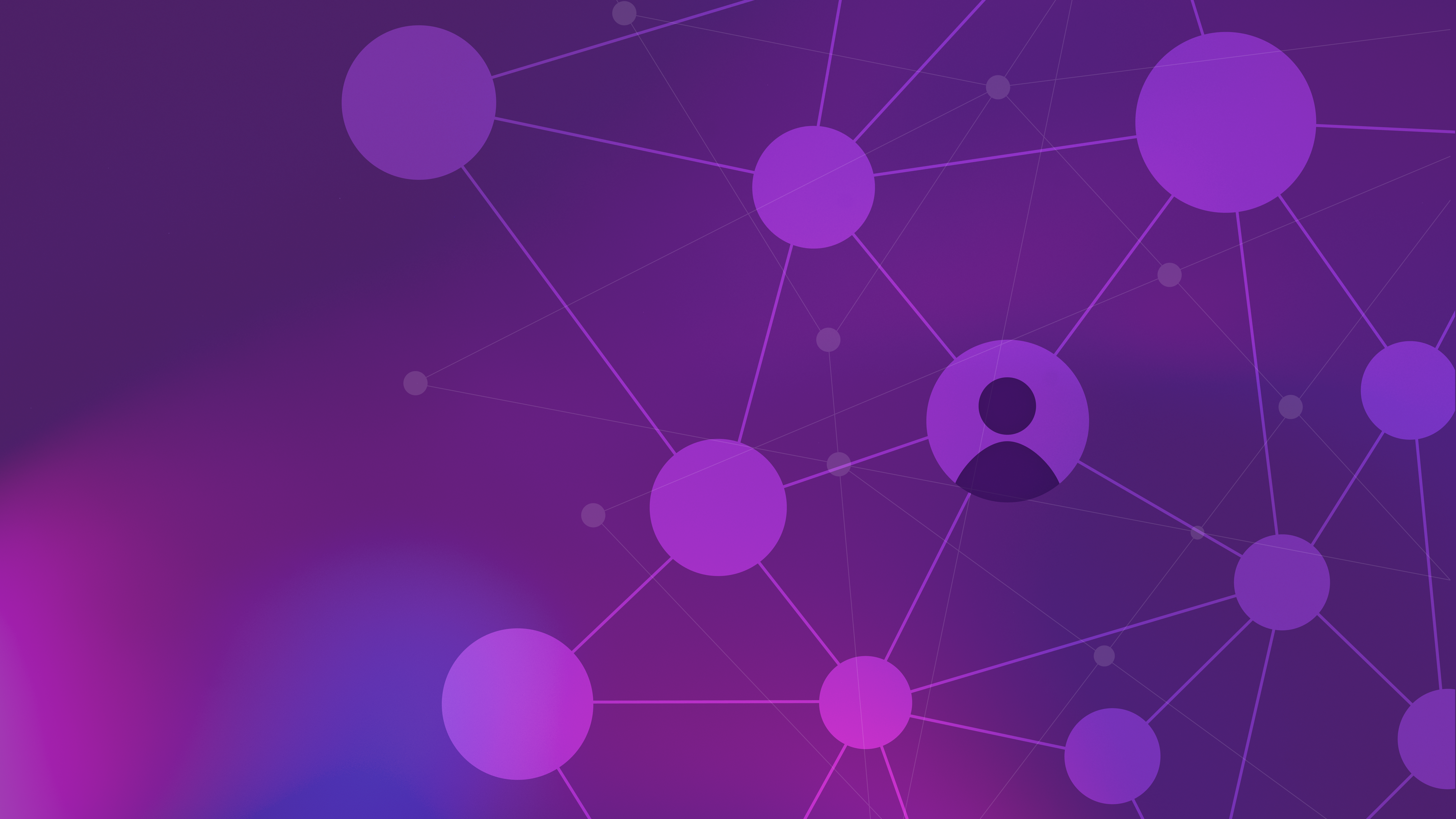From Linearity to (Basically) the Multiverse
It’s an idea that dates back to 1898, to Elias Elmo Lewis who first created the purchase funnel, an idea so successful that we use it in marketing and sales over 100 years later.
With its straightforward progression from awareness to conversion, the funnel became the gold standard because… it really worked. However, new tools developed in the last 20 years have changed the way we need to think about and use the funnel.

As time and technology have advanced, so have the nuances of the customer journey. Their course through the funnel has evolved from a linear path into a multi-dimensional odyssey filled with new hazards and opportunities.
Think about it. How many touchpoints and personalized experiences are you presented with daily, just through your phone? How is messaging presented to you, and at what point do tactics find you in the funnel? Why aren’t these questions easier to answer??
Well, the funnel has expanded, turned in on itself, and become vastly more complex and intricate over time — our old model needs updating. This shift demands business leaders and marketers rethink their strategies and more deeply explore how their customers make a purchasing decision.
Okay, here’s a revelatory question: What if the essence of modern marketing can’t be reduced to guiding a customer along a predetermined path? What if (and stick with us here) it’s about expanding not just that path but our understanding of how to engage with the customer at each point along their (now multi-dimensional) journey?
You’d need to understand and anticipate this customer’s dreams and challenges on an intimate, ongoing basis. You’d need to do this for every potential customer. This transforms the funnel from something flat and linear into a vast, strategic framework.
Through (Rational) Simplicity to (Emotional) Complexity
Our understanding of the marketing funnel is a well-worn path, clear and direct. From the moment customers became aware of a product or service, they’d journey down into the funnel and ultimately make a purchasing decision. It’s straightforward, predictable, and easy to visualize and navigate.
But as the old saying goes, “The map is not the territory.”
Marketers like using the funnel as a one-size-fits-all approach to consumer behavior. Each moment spent focused on hitting KPIs throughout the funnel is a moment spent ignoring the foundational human psychology that supports the framework of the funnel.
Behind every performance metric, behind every node of engagement, is a real person.
Like you, they have a day job. They hate the hassle of traffic, they plan vacations, and they dream about what could have been and what might yet be.
Like any of us, they deserve to be understood.
And if we want to persuade them into making a purchase decision that addresses their needs, we absolutely MUST understand and validate them as human.
Linearity is Ineffective (and Boring)
Today, we interact with brands ALL OF THE TIME. Or close enough that distinctions are irrelevant. 
You’re a modern consumer. You’re savvy. You know generic marketing tactics when you see them. But do you recognize the subtler tactics when used upon you? Are you ever rationally aware of when and how you’ve crossed the threshold from consideration to purchasing decision? That’s a tricky one.
The traditional marketing funnel is built around rational considerations we’re familiar with, like features, benefits, and costs.
But we’re viewing the funnel through the lens of behavioral psychology and can see that emotional biases sway customer choices at each stage.
And here’s the secret: the psychology behind how we make decisions has gone unchanged for millennia.
Let’s break it down:
- Awareness: More than building awareness by informing the customer, we want to trigger an emotional connection, piquing their curiosity and interest. We want brand stories that resonate with the prospective customer's emotional narratives and motivate them to seek more information.
- Consideration: During the consideration stage, customers weigh their options in a more personalized, emotional context. It becomes less about product features and more about how the product fits into the customer's emotional landscape.
- Decision: This emphasis on emotional fit continues into the decision-making phase, where the act of purchasing serves not just as a logical conclusion but as emotional validation, affirming the feelings and biases that initially guided the customer's interest.
- Feedback: The post-purchase feedback stage will either validate or challenge the emotional decisions made by the customer (ProTip: we want to validate it). Positive feedback amplifies emotional satisfaction and can lead to the kind of brand loyalty that turns customers into brand evangels.
Now what does this all look like in action?
Embracing Depth, Volume, and Complexity
Let’s map out the modern consumer’s journey. We’ll call him Alex (hi, Alex!).
Alex starts his day scrolling through his feed and sees an advertisement showcasing the latest smart home devices. The content he encounters builds awareness of the products.
As the week continues, Alex goes about his routine and encounters more ads touching not just on smart home devices but also the feelings and lifestyle that their purchase promises.
Logically, Alex understands the primary utility of these smart home devices: convenience.
A smart thermostat can regulate his home’s temperature without manual intervention. A smart speaker can play his favorite album on command. A smart security system can ensure his family’s safety even when he’s miles from home.
Underneath his logical understanding of these smart home devices is the aspirational value associated with the smart home lifestyle. Owning these devices casts Alex as a forward-thinker, someone in sync with the latest technological trends.
This aspiration value is almost always subconscious, conveying the allure of a given product’s associated feelings.
The unspoken desires — for efficiency, optimizing his life, achieving the prestige of being “in the know” — resonate with Alex far more than any smart thermostat ever will.
Deciphering the Layers and Recognizing the Patterns
Do you see the pattern? The crucial junction? It starts with awareness, progresses with logical understanding, and culminates in emotional consideration, all before conversion and loyalty.
Alex isn’t alone in this journey, either. Millions of people go through the exact same process, albeit with variations based on their unique experiences and preferences. You do, too.
This pattern isn’t random or isolated. It’s a manifestation of the internal push and pull that occurs whenever we make purchasing decisions.
When marketing professionals and business leaders tap into this pattern, they can anticipate consumer needs and desires even before their customers are fully aware of them. It’s the same old funnel, fuller and richer (and more crowded) than Elias Elmo Lewis ever dreamed.
Reactive vs. Predictive Strategies
There is a transformative potential in redefining our perspective of the funnel. The old model stopped at identifying the need for convenience in smart devices. With our fresh understanding, we see what we once thought was flat and linear is deep, messy, and human.
There’s no more one-size-fits-all approach, and that changes the game completely.
If this new funnel represents a shift in strategy, then the tactics that fill it must also shift. In part, that entails crafting messaging that resonates with consumers on a deeper, more intrinsic, and elemental level.
It also requires a re-think of what we do, and when. If we can do this, we can guarantee conversion and ironclad loyalty.
Bridging the Gap between Strategy and Execution
Strategy and tactics. There’s the plan, and then there’s executing the plan. 
No matter what you call them, there’s always a give and take between the two. When strategy shifts, so do tactics. When the tactical game changes, it’s time to rethink strategy.
One way to think about strategy and execution is through the lighthouse metaphor. Casting its beam far and wide to guide ships at sea, the lighthouse represents strategy.
But light is not enough.
Left alone, ships will crash along the shore and into one another, lighthouse or not. Each ship needs a pilot, someone executing the function of the ship itself, to steer it safely through treacherous, if well-lit, waters.
Strategy alone doesn’t move the ship. In fact, a rigid strategy might become an anchor rather than a guiding beacon. Good strategy provides direction and accounts for its own fallibility.
Rapid technological advancements and shifting consumer behaviors reshape our world day by day, leaving even the most meticulous strategies to occasionally falter.
Recognizing this fluidity allows marketing professionals and business leaders to remain adaptive with their strategies and pivot their tactics when needed.
That means categorizing the kinds of purchase decisions being made, and recognizing who is making them and when. Our exploration of these categories will comprise the rest of this blog series.
From Linear Journeys to Multi-Dimensional Masterpieces
Marketing is in constant, unceasing, iterative motion. It ebbs and flows with every wave of innovation and shift in consumer sentiment.
But what never changes is the underlying emotional logic we all exercise when moving from awareness to consideration and from conversion to loyalty. It’s a perfectly irrational rationale we use, whether or not we’re aware of it, even if we convince ourselves otherwise.
After all, we’re only human.
The shift in our understanding from two-dimensional linearity to a multi-dimensional web of decision-making is more than a new paradigm — it’s recognizing and tapping into the psychology of human behavior. It’s modern marketing.
Recapping the New Era
Two-dimensional strategies and linear approaches are in the rearview mirror. Today's customer journey is complex, blending emotion and logic at every step.
Today, effective marketing needs both a solid strategy and the flexibility to adapt. While the strategy sets the course, real-world execution provides invaluable insights. It’s not just about following a plan but about knowing when to innovate or even cast the plan aside.
In this intricate landscape, Deksia serves as your guide. We turn challenges into opportunities for innovation and meaningful customer engagement. Our approach goes beyond one-size-fits-all solutions.
We’re not specialists in any particular industry vertical — we’re experts in persuasion and decision-making.
Ready to upgrade your marketing game? Book a free 30-minute consultation with Deksia today.
We'll help you identify your target audience, fine-tune your funnel strategy, and sharpen your messaging, using the principles discussed throughout this blog.
We're here to empower you with actionable insights. Secure your slot now and give your marketing a competitive edge.



